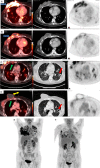Dramatic response of metaplastic breast cancer to chemo-immunotherapy
- PMID: 28649648
- PMCID: PMC5445614
- DOI: 10.1038/s41523-017-0011-0
Dramatic response of metaplastic breast cancer to chemo-immunotherapy
Abstract
Frequent overexpression of programmed death-ligand 1 has recently been demonstrated in metaplastic breast cancer, which is a rare breast cancer subtype with limited treatment options. This report describes the clinical course of a patient with metastatic metaplastic breast cancer who had a remarkable response to anti-programmed death-1 therapy with pembrolizumab in combination with nab-paclitaxel. Tissue correlates are presented including tumor-infiltrating lymphocytes and high-programmed death-ligand 1 expression in the tumor.
Conflict of interest statement
The authors declare no conflict of interest.
Figures



References
LinkOut - more resources
Full Text Sources
Other Literature Sources
Medical
Research Materials

